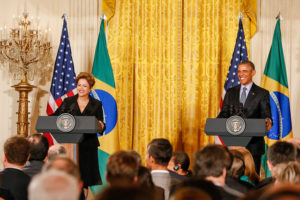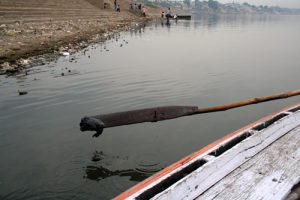Chinese plans for the Magdalena river, Colombia’s main fluvial artery, top the list of concerns for the South American country’s environmental organizations. Drawn up between 2012 and 2014, the majority of the master plan to take advantage of the river was financed by Chinese with the aim of assessing its potential for navigability, land exploitation and energy generation.
The plan developed by Hydrochina intends to convert the Magdalena into an aquatic superhighway enabling the transportation of huge cargos around the clock. Resources such as coal, palm oil and petroleum are expected to move along the river as they represent 80% of the cargo that passes through Colombian ports. At the same time, the plan includes the construction of 19 dams, which could displace fishermen and rural and indigenous communities.
“Many people live along and depend on this river. Fishermen are very worried as theirs is the only way of life they know. The wetlands are fundamental to protecting against the big floods in rainy season,” said Juan Carlos Vargas, Co-Director of the Alma Foundation. “China has a business agenda with the river. It wants to harness its productivity to make it competitive.”
More than 1,500 kilometres in length, the Magdalena stretches over a considerable part of Colombia and is navigable from the town of Honda in the department of Tulima in the central Andean region, to its mouth on the Caribbean coast. 80% of Colombia’s population lives in the Magdalena basin, which covers 24% of the country’s territory. The basin covers 18 administrative departments and is responsible for generating 85% of the country’s GDP. But according to the master plan, it’s potential is even greater.
The Navalena Consortium, which includes Brazil’s Odebrecht and Valorcon of Colombia, has already embarked on a US$ 1.3 billion project to ensure that the river will be navigable 24 hours a day within five years. These companies will be in charge of the construction and maintenance of 908 metres of a navigable canal and the construction of nine ports. But environmental organizations warn that there are no more than 50 documents available that show how the river will work, whereas during tendering there were said to be more than 700.
“There are many environmental questions hanging over this. We don’t know what will happen with the swamps and wetlands that depend on the river,” said Margarita Florez, Director of the Colombian civil society group Ambiente y Socieded (Environment and Society). “The alluvial zones weren’t taken into account in the master plan. No one asked us what we thought of the document,” she added.
Despite having expanded its presence in Latin America without much difficulty, China is faced with big challenges in Colombia in the form of pressure from social and environmental groups. These groups are concerned about some of the Chinese-funded projects that form part of the country’s plan to increase the volume of trade with Colombia and they have already claimed their first victory.
China has undertaken a huge diplomatic and commercial push to improve relations with Latin America and Colombia is no exception. China has consolidated its position as Colombia’s second largest trading partner, having replaced Venezuela, and it is catching up with the United States. Chinese products represent 18% of all Colombia’s imports.
But one characteristic that separates Colombia from the rest of the region is that there has been widespread and organized opposition to Chinese projects because of the risks they pose to the environment. This was demonstrated during the recent visit of Chinese premier Li Keqiang, when green groups presented him with a letter expressing their dissatisfaction and demanding to know more about China’s plans for Colombia.
“Over the past decade, we have witnessed the intensification of commercial, cultural and technological relations between China and our country, represented by government accords. We know your stance with respect to the environment in your country; supporting policies that promote economic growth without infringing communities,” read the letter signed by more than 10 organizations. The signatories also requested a meeting with Li, which did not materialize.
More projects, More unknowns
Even through the details are unknown, the number of deals recently signed between China and Colombia bring with them a wide range of projects, some of which were mentioned specifically during Li Keqiang’s visit. The vast Orinoquía region in the east of the country will be subject to infrastructure development that will include a highway that runs alongside the Meta river, the final stretch of which borders Venezuela. The project also includes making the Meta navigable to facilitate agricultural development in the region which comprises mostly of savannahs.
Another standout project will focus on Buenaventura, Colombia’s most important Pacific port, which is engulfed by a humanitarian crisis caused by conflict between criminal gangs. Colombian president Juan Manuel Santos announced that with China’s support they will breath “new life” into the city. It is estimated that the US$ 3billion Buenaventura project will integrate industrial, logistical, automotive, agricultural and infrastructure development and will begin in 2016. But as with the other deals, details are scarce.
“We’re also looking at a Chinese-funded oil pipeline project. It will be located in the centre of the country and will run alongside the Magadalena, but many of the details are still unknown,” said Florez.
The first victory
As a result of a recent lawsuit brought by the environmental organization Tierra Digna, the State Council ordered the suspension of presidential decrees that identified 516 zones, more than 20% of national territory, as strategic mining areas that would be handed over to private companies after a tendering process. The court ruled that consultation with indigenous peoples must be undertaken before the project could advance.
The areas identified by the government are of great environmental importance, argues Ximena González, director of Tierra Digna, who does not rule out that Chinese companies will be among those interested in the mining projects. They could see their further entry into Colombia restricted by the ruling.
“The decision to demarcate these areas for mining projects was taken by the government behind closed doors, without first carrying out an environmental survey of the territory. The objective was to favour foreign investment since there are no Colombian mining companies and I wouldn’t rule out that this comes through China,” said Gonzalez.
There are no Chinese mining companies currently working in Colombia, with the majority coming from Canada, South Africa, the UK and the US including Glencore, Drummond, AngloAmerican and BHP Billiton. Gold, platinum, coal and coltan (a black metal ore) are the most sought after commodities according to González.
Growing relationship
Just a decade ago Colombia bought US$ 1 billion worth of Chinese products annually, but after a staggering increase this hit US$ 10 billion last year. Not only have imports consisted of typical products like clothes and shoes, but they now include electrical appliances, mobile phones, machinery, iron, steel and chemicals, among others. Big Chinese multinationals like Huawei, ZTE, Sinopec, HydroChina, Capital Airport Holding, Tiens and T-P link have established themselves in Colombia.
China and Colombia have also explored the possibility of negotiating a free trade agreement. President Santos mentioned a possible agreement two years ago during a visit to China but conversations have not advanced because of fears from Colombian business about its weak bargaining power given the contrasting size of China’s industrial sector.
Gina Rodriguez, Director of the China-Colombia Chamber of Trade and Integration, highlighted the importance of the alliance with China because of the potential that it has for the Colombian economy. But she too wants to know more details about the recent projects in order to evaluate their environmental impacts.
“These projects are only superficially known. I can’t say whether or not they’re going to harm the environment. The Chamber always analyses new projects, and that’s what we’re going to do. These initiatives are still being managed and lack detailed analyses. We have to look at them closely and analyse the potential repercussions,” said Rodriguez.




